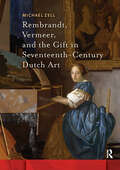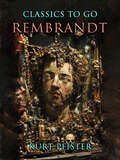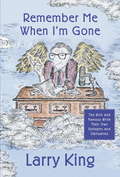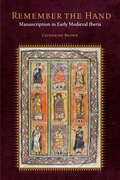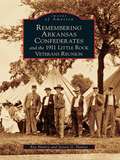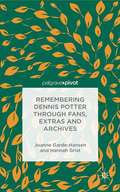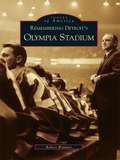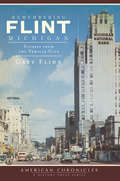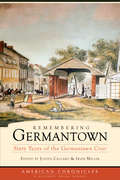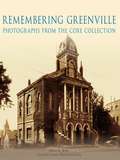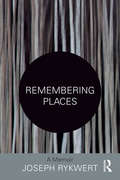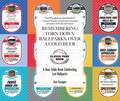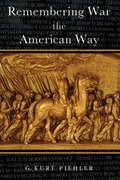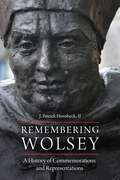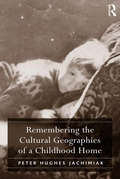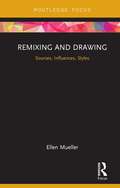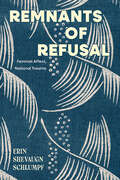- Table View
- List View
Rembrandt, Vermeer, and the Gift in Seventeenth-Century Dutch Art (Amsterdam Studies in the Dutch Golden Age)
by Michael ZellRembrandt, Vermeer, and the Gift in Seventeenth-Century Dutch Art offers a new perspective on the art of the Dutch Golden Age by exploring the interaction between the gift's symbolic economy of reciprocity and obligation and the artistic culture of early modern Holland. Gifts of art were pervasive in seventeenth-century Europe, and many Dutch artists, like their counterparts elsewhere, embraced gift giving to cultivate relations with patrons, art lovers, and other members of their social networks. Rembrandt also created distinctive works to function within a context of gift exchange, and both Rembrandt and Vermeer engaged the ethics of the gift to identify their creative labor as motivated by what contemporaries called a love of art, not materialistic gain. In the merchant republic’s vibrant market for art, networks of gift relations and the anti-economic rhetoric of the gift mingled with the growing dimension of commerce, revealing a unique chapter in the interconnected history of gift giving and art making.
Rembrandt. The Painter Thinking
by Ernst WeteringEven during the artist's lifetime, contemporary art lovers considered Rembrandt van Rijn (1606-1669) to be an exceptional artist. In this revelatory sequel to the acclaimed Rembrandt: The Painter at Work, renowned Rembrandt authority Ernst van de Wetering investigates the painter's considerations that determined the striking changes in his development from an early age onwards. This gorgeously illustrated book explores how Rembrandt achieved mastery by systematic exploration of the 'foundations of the art of painting'. According to written sources from the seventeenth century, which were largely misinterpreted until now, these 'foundations' were considered essential at that time. From his first endeavours in painting, Rembrandt embarked on a journey past these foundations, thus becoming the 'pittore famoso', whom Count Cosimo the Medici visited at the end of his life. Rembrandt never stopped searching for solutions to the pictorial problems that confronted him; this led over time to radical changes that cannot simply be attributed to stylistic evolution or natural development. In a quest as rigorous and novel as the artist's, Van de Wetering reveals how Rembrandt became the revolutionary painter that would continue to fascinate the art world. This ground breaking exploration reconstructs Rembrandt's theories and methods, shedding new light both on the artist's exceptional accomplishments and on the theory and practice of painting in the Dutch Golden Age.
Rembrandt: Neubearbeitung Der Ungekürzten Originalfassung (Classics To Go)
by Kurt Pfister"Rembrandt" von Kurt Pfister bietet einen tiefgehenden Einblick in die komplexe Welt eines der rätselhaftesten und einflussreichsten Künstler des 17. Jahrhunderts – Rembrandt van Rijn. Das Buch beleuchtet nicht nur Rembrandts künstlerische Meisterwerke, sondern widmet sich auch seinem persönlichen Leben und fängt das feine Zusammenspiel zwischen seinem schöpferischen Genie und seinen menschlichen Schwächen ein. Pfister zeichnet ein Porträt Rembrandts, das seinen Kampf und seine Erfolge hervorhebt, seinen Weg durch ein bewegtes soziales und wirtschaftliches Umfeld nachzeichnet und seinen bleibenden Einfluss auf die Kunstwelt würdigt. Durch Pfisters Perspektive erscheint Rembrandt als eine Figur, die sich über die Konventionen seiner Zeit hinwegsetzte – Licht und Schatten dienten ihm nicht nur als künstlerische Mittel, sondern auch als Metaphern für die menschliche Erfahrung an sich. Die Themen Widerstandskraft, das Streben nach Authentizität und die Auseinandersetzung mit der menschlichen Existenz sprechen stark Menschen von heute an – in einer Welt, in der Echtheit zunehmend mehr geschätzt wird als bloßer Schein und persönliche Kämpfe oft vor dem Hintergrund gesellschaftlichen Wandels stattfinden. Rembrandts Geschichte erinnert im heutigen Leben an die zeitlose Kraft von Kunst und Ausdruck. Das Buch bietet nicht nur Kunstliebhabern und Historikern wertvolle Einblicke, sondern auch allen, die sich für die universelle Suche nach Sinn und Selbstausdruck interessieren. Es lädt Leserinnen und Leser ein, die in Kunst, Geschichte und menschlichen Geschichten Inspiration finden, eine Persönlichkeit zu entdecken, deren Leben so vielschichtig war wie seine gefeierten Werke.
Remember Me When I'm Gone: The Rich and Famous Write Their Own Epitaphs and Obituaries
by Larry King“Show me Heaven! I have seen hell.” —Patricia NealLarry King, world-famous radio and television personality, has asked the talented, the beautiful, the wise, and the rich a question all of us have pondered: How would you like to be remembered after your death? The result is REMEMBER ME WHEN I'M GONE, an entertaining and eloquent collection of “last words” from people in the arts, in politics, in sports, and in business, mostly still alive. In telling and moving reflections, often leavened by self-deprecating humor, these celebrities look back on their lives, their ambitions, their mistakes, and their accomplishments.The contributions range from pithy one-liners by Yogi Berra (“It’s over.”), Dave Barry, George Carlin, and Liz Smith (“Excuse my dust!”); to inspired sketches by Stephen King and Peter Falk; to candid reflections from Don Shula, Fred Rogers, and Chevy Chase; to hilarious rants from Margaret Cho and Tommy Lee; and a last request by Arthur Hailey. Often surprising and always memorable, REMEMBER ME WHEN I'M GONE is a timeless collection by stars who will live on forever.
Remember This Fresh Page Ideas to Scrapbook the Year: Fresh Page Ideas to Scrapbook the Year
by Kimber Mcgray Summer FullertonScrapbook all year long! It's not hard to remember life's big events, like your son's birthday or your annual trip to the beach. But finding fresh ways to scrapbook these events, to commemorate them in a way that means as much as the event itself - that can be tricky! With 120 fresh layout ideas,Remember Thiswill inspire you to scrap a variety of creative layouts during every season of the year. With pages featuring multiple photos, numerous styles and a variety of events and activities, there's something for every scrapbooker. Brighten your memories of each season with: Layouts expressly designed for holidays, seasonal activities and special occasions 10 fully illustrated techniques - try a new technique to add some sparkle 15 multi-photo layout sketches - capture the moment from every angle Checklists for keeping track of seasonal events - don't miss the first bloom of spring A calendar template to plan a month's worth of scrapping - create the time to scrapbook those seasonal memories Whether you're a seasoned scrapper or new to the craft,Remember Thisgives you everything you need to keep scrapbooking all year long.
Remember the Hand: Manuscription in Early Medieval Iberia (Fordham Series in Medieval Studies)
by Catherine BrownRemember the Hand studies a body of articulate manuscript books from the Christian monasteries of northern Iberia in the tenth and eleventh centuries. These exceptional, richly illuminated codices have in common an urgent sense of scribal presence—scribes name themselves, describe themselves, even paint their own portraits. While marginal notes, even biographical ones, are a common feature of medieval manuscripts, rarely do scribes make themselves so fully known. These writers address the reader directly, asking for prayers of intercession and sharing of themselves. They ask the reader to join them in not only acknowledging the labor of writing but also in theorizing it through analogy to agricultural work or textile production, tending a garden of knowledge, weaving a text out of words.By mining this corpus of articulate codices (known to a school of Iberian codicologists, but virtually unstudied outside that community), Catherine Brown recovers these scribes’ understanding of reading as a powerful, intimate encounter between many parties—authors and their text, scribes and their pen, patrons and their art-object, readers and the words and images before their eyes—all mediated by the material object known as the book. By rendering that mediation conspicuous and reminding us of the labor that necessarily precedes that mediation, the scribes reach out to us across time with a simple but profound directive: Remember the hand.Remember the Hand is available from the publisher on an open-access basis.
Remembering Arkansas Confederates and the 1911 Little Rock Veterans Reunion (Images of America)
by Ray Hanley Steven G. HanleyArkansas seceded from the Union in 1861, opening a chapter in the state's history that would change its destiny for decades. An estimated 6,862 Arkansas Confederate soldiers died from battle and disease, while some 1,700 Arkansas men died wearing Union blue. Total casualties, killed and wounded, represented 12 percent of the white men in the state between the ages of 15 and 62. Bloody, hard-fought battles included Pea Ridge, Helena, Little Rock, and the rare Confederate victory in southwest Arkansas at Jenkins' Ferry. Following the war, the event that included the largest parade ever in Arkansas, the 1911 United Confederate Veterans Reunion, is presented in picture and word. The event has largely been neglected by history books. From the monuments and veterans to the loyal reenactors still gathering today, the story of the Civil War in Arkansas is remembered and preserved for coming generations.
Remembering Chapel Hill: The Twentieth Century As We Lived It (American Chronicles)
by Valarie SchwartzSince the 1789 charter of the country�s first state university, Chapel Hill has attracted people from all over who found that the town was the perfect place to put down roots. In this collection, local newspaper columnist Valarie Schwartz celebrates many of Chapel Hill�s most notable residents, from the World War II veteran who came to law school after the war and ended up as president of the UNC system for thirty years to the couple from the Midwest who arrived in 1935 and spent their careers building the North Carolina Symphony Orchestra. Featuring stories of struggle and success from all walks of life, Remembering Chapel Hill is a tribute to the twentieth-century citizens who made the city what it is today: �a Southern slice of heaven.�
Remembering Columbia
by John M. Sherrer III Historic ColumbiaColumbia, South Carolina, is very much a tale of two cities. Founded as a political compromise, forged by an economy shackled by slavery, and physically vanquished by fire, the Palmetto State's second capital became a proving ground for a new society less than a century after its establishment. During the course of the next 100 years, Columbians--new and old, black and white, rich and poor--would physically transform their city in ways that reflected their needs, aspirations, fears, and wherewithal. ?Remembering Columbia is a visual road map that merges images with accounts of people, sites, and events pulled from historical newspapers, diaries, and ephemera. Building upon the efforts of previous generations, this account explores South Carolina's capital city from its early years through the mid-20th century in ways previously underdeveloped or altogether unrepresented. The result is an intriguing detective story that will be enriching, surprising, and compelling to life-long residents, newcomers, and visitors alike.
Remembering Dennis Potter Through Fans, Extras and Archives
by Joanne Garde-Hansen Hannah GristAn accessible case study of television heritage, Remembering Dennis Potter Through Fans, Extras and Archive draws on the memories of fans and extras of Potter's productions. In providing insight into issues of visibility, memory and television production, it fulfils a vital need for better understanding of television production history as heritage.
Remembering Detroit's Olympia Stadium
by Robert WimmerFor over a half century Olympia Stadium was THE entertainment venue in Detroit. Almost every major sports and entertainment event was played there. The major tenant was the Detroit Red Wings. Most of the major touring ice shows also skated at the Olympia; great entertainers such as Elvis, the Beatles, KISS, Isaac Hayes, Alice Cooper, Lawrence Welk, John Denver, the Lone Ranger, and the Globetrotters stopped by to perform. In Remembering Detroit's Olympia Stadium, the author leads the reader on a fascinating journey, through the use of over 200 historic photographs, allowing us a glimpse into that building on Grand River and McGraw that was a second home to many. This volume also features the people behind the scenes who made the popcorn, cleaned the ice, sold drinks and food; took your tickets; saw you to your seats. The media, which reported the events on radio, TV, and in the newspapers, and the Red Wing Alumni who have been skating for over 40 years in old timers games rising money for charities, are all part of this celebration of Detroit's history.
Remembering Flint, Michigan: Stories from the Vehicle City (American Chronicles)
by Gary FlinnHop in for a ride with local history columnist Gary Flinn to the halcyon days of Flint. Revisit the contributions of oft-overlooked David Buick, the inventive and invaluable Flint auto pioneer who lacked the business savvy to become an auto legend. Travel back to the original Kewpee Burger and wash it down with an old Vernor's Ginger Ale before catching a show at Capitol Theatre. Fast-forward a few years and flip open a copy of the Flint Voice, the alternative newspaper published by controversial filmmaker and Flint native Michael Moore. Come along for the journey and time travel through Flint--the Vehicle City.
Remembering Germantown: Sixty Years of the Germantown Crier (American Chronicles)
by Irvin Miller Judith CallardWith grit and gumption, the residents of Germantown propelled their community from a sleepy backwater to a thriving urban neighborhood. Through charming first-person accounts and fascinating narratives culled fromsixty years of the Germantown Crier, readers may catch a glimpse of the feisty Germantowners who proudly honor their past without ceasing to move forward. Meet cantankerous Ann Shermer, a nineteenth-century Bethlehem Pike tollkeeper who enforced the fare with the help of her trusty flintlock pistol, and the town�s enforcer of morality, �civilizer� Samuel Harvey. Whether a tale from the storied King of Prussia Inn, which housed greats like George Washington and Gilbert Stuart, or a memory of a childhood encounter with Louisa May Alcott, each vignette in this collection crafts a poignant portrait.
Remembering Greenville: Photographs From the Coxe Collection (Images of America)
by Greenville County Historical Society Jeffery WillisAnchored at the foot of the Blue Ridge Mountains, Greenville is the cultural center of South Carolina's Piedmont. Today, residents and tourists often find themselves immersed among the charming shops and quaint cafes that line the avenues in the historic Main Street district. A revitalized area today, Greenville's Main Street was the commercial center of the town during the life of William Coxe, a Greenville photographer who acquired many early images and who brilliantly extended the collection with his own photographs. Remembering Greenville: Photographs from the Coxe Collection explores Greenville during the first half of the 20th century. Stunning black-and-white images enlighten readers about the "old" Greenville that virtually disappeared as the small city was transformed into a large metropolitan area. These images, taken from the 1900s to the 1960s, depict Furman University and Greenville Women's College, both then located in Greenville's downtown; Camp Wetherill, Greenville's Spanish-American War training camp; and such personalities as an older, but still legendary, "Shoeless" Joe Jackson.
Remembering Mass Violence
by Steven High Thi Ry Duong Edward LittleRemembering Mass Violence breaks new ground in oral history, new media, and performance studies by exploring what is at stake when we attempt to represent war, genocide, and other violations of human rights in a variety of creative works. A model of community-university collaboration, it includes contributions from scholars in a wide range of disciplines, survivors of mass violence, and performers and artists who have created works based on these events.This anthology is global in focus, with essays on Africa, Asia, Europe, Latin America, and North America. At its core is a productive tension between public and private memory, a dialogue between autobiography and biography, and between individual experience and societal transformation. Remembering Mass Violence will appeal to oral historians, digital practitioners and performance-based artists around the world, as well researchers and activists involved in human rights research, migration studies, and genocide studies.
Remembering Places: A Memoir
by Joseph RykwertBorn in Warsaw in 1926, Joseph Rykwert was one of the best-known critics and historians of architecture. One of very few writers to be awarded the RIBA’s highest honour, the Royal Gold Medal, in 2014, and author of countless books and essays, his influence over the past 60 years cannot be underestimated.In this new posthumous edition of his memoir, he expands upon the first edition by 20,000 words, delving deeper into how his life’s experiences shaped his working life. He addresses the dualities between which he had to navigate: Jewish/Polish, Polish/British and later Practice/Scholarship. He spent most of his working life between the US and UK, and worked as a designer, teacher and a writer; as such, his groundbreaking ideas and work have had a major impact on the thinking of architects and designers since the 1960s, and continue to do so to this day.
Remembering Places: The Autobiography Of Joseph Rykwert
by Joseph RykwertBorn in Warsaw in 1926, Joseph Rykwert is one of the best-known critics and historians of architecture. One of very few writers to be awarded the RIBA’s highest honour, the Royal Gold Medal, in 2014, and author of countless books and essays, his influence over the past 60 years cannot be underestimated. In this memoir he tells for the first time of how his life’s experiences shaped his working life. He addresses the dualities between which he had to navigate: Jewish/Polish, Polish/British and later, Practice/Scholarship. He spent most of his working life between the US and UK and worked both as a designer and a writer; as such his ground-breaking ideas and work have had a major impact on the thinking of architects and designers since the 1960s and continue to do so to this day.
Remembering Torn-Down Ballparks, Over a Cold Beer: A Beer Table Book Celebrating Lost Ballparks
by Ken FinniganThe perfect beer-table book for fans of the Great American Pastime—regardless of team affiliation! Beginning with Comiskey Park in 1990, author Ken Finnigan used to take road trips to many ancient remaining ballparks with his oldest brother. The idea was to see them just before they got knocked down, instead of imagining what they were like after demolition. They went on journeys to quite a few other old baseball stadiums in the early 1990s and even investigated some of the former sites where ballparks were decommissioned years before. Most of the sites he saw in the early 1990s are no longer standing. Remembering Torn-Down Ballparks, Over a Cold Beer, through vintage full-color art featured on beer coasters, reveals what it may have been like to see the stadiums that are no longer around. From the journal-styled observations of each ballpark, to the artwork from the coasters and the artifacts depicted, Finnigan offers baseball enthusiasts a sense of having a piece from each ballpark.
Remembering War the American Way
by G. Kurt PiehlerWars do not fully end when the shooting stops. As G. Kurt Piehler reveals in this book, after every conflict from the Revolution to the Persian Gulf War, Americans have argued about how and for what deeds and heroes wars should be remembered.Drawing on sources ranging from government documents to Embalmer's Monthly, Piehler recounts efforts to commemorate wars by erecting monuments, designating holidays, forming veterans' organizations, and establishing national cemetaries. The federal government, he contends, initially sidestepped funding for memorials, thereby leaving the determination of how and whom to honor in the hands of those with ready money--and those who responded to them. In one instance, monuments to "Yankee heroes" erected by the Daughters of the American Revolution were countered by immigrant groups, who added such figures as Casimir Pulaski and Thaddeus Kosciusko to the record of the war. Piehler argues that the conflict between these groups is emblematic of the ongoing reinterpretation of wars by majority and minority groups, and by successive generations.Demonstrating that the battles over the Vietnam Veterans Memorial are not unique in American history, Remembering War the American Way reveals that the memory of war is intrinsically bound to the pluralistic definition of national identity.
Remembering Wolsey: A History of Commemorations and Representations
by J. Patrick IIRemembering Wolsey seeks to contribute to our understanding of historical memory and memorialization by examining in detail the commemoration and representation of the life of Thomas Wolsey, the sixteenth-century cardinal, papal legate, and lord chancellor of England. Hornbeck surveys a wide range of representations of Cardinal Wolsey, from those contemporary with his death to recent mass-market appearances on television and historical fiction, to go beyond previous scholarship that has examined Wolsey only in an early modern context.Remembering Wolsey contributes significantly to the ongoing reimagining of English church history in the years prior to the Reformation. Surveying chronicle accounts, pamphlets, plays, poems, historical fictions, works of historical scholarship, civic pageants and monuments, films, and television programs, the book shows how an extended sequence of authors have told widely varying stories about Wolsey’s life, often through the lens of their own religious and ideological commitments and/or in response to the pressing concerns of their times.
Remembering the Cultural Geographies of a Childhood Home
by Peter Hughes JachimiakUsing an innovative auto-ethnographic approach to investigate the otherness of the places that make up the childhood home and its neighbourhood in relation to memory-derived and memory-imbued cultural geographies, Remembering the Cultural Geographies of a Childhood Home is concerned with childhood spaces and children's perspectives of those spaces and, consequentially, with the personalised locations that make up the childhood family home and its immediate surroundings (such as the garden, the street, etc.). Whilst this book is primarily structured by the author's memories of living in his own Welsh childhood home during the 1970s - that is, the auto-ethnographic framework - it is as much about living anywhere amid the remembered cultural remnants of the past as it is immersing oneself in cultural geographies of the here-and-now. As a result, Remembering the Cultural Geographies of a Childhood Home is part of the ongoing pursuit by cultural geographers to provide a personal exploration of the pluralities of shared landscapes, whereby such an engagement with space and place aid our construction of cognitive maps of meaning that, in turn, manifest themselves as both individual and collective cultural experiences. Furthermore, touching upon our co-habiting of ghost topologies, Remembering the Cultural Geographies of a Childhood Home also encourages a critical exploration of children’s spirituality amid the haunted cultural and geographical spaces and places of a house and its neighbourhood: the cellar, hallway, parlour, stairs, bedroom, attic, shops, cemeteries, and so on.
Remix: Changing Conversations in Museums of the Americas
by Selma Holo and Mari-Tere ÁlvarezCelebrating the diversity of institutions in the United States, Latin America, and Canada, Remix aims to change the discourse about museums from the inside out, proposing a new, "panarchic"—nonhierarchical and adaptive—vision for museum practice. Selma Holo and Mari-Tere Álvarez offer an unconventional approach, one premised on breaching conventional systems of communication and challenging the dialogues that drive the field. Featuring more than forty authors in and around the museum world, Remix frames a series of vital case studies demonstrating how specific museums, large and small, have profoundly advanced or creatively redefined their goals to meet their ever-changing worlds. Contributors: Piedade Grinberg (Brazil), Nichole Anderson (Canada), Dr. James D. Fleck O.C. (Canada), Vanda Vitali (Canada), Lydia Bendersky (Chile), Andres Navia (Colombia), Manuel Araya-Incera (Costa Rica), Oscar Arias (Costa Rica), Alejandro de Avila Blomberg (Mexico), Marco Barerra Bassols (Mexico), Cuauhtémoc Camarena Ocampo (Mexico), Miguel Fernández Félix (Mexico), Demian Flores (Mexico), Teresa Morales (Mexico), Nelly Robles (Mexico), Hector Feliciano (Puerto Rico), Mario Vargas Llosa (Peru), Santiago Palomero Plaza (Spain), Maxwell L. Anderson (United States), Susana Bautista (United States), Graham W. J. Beal (United States), Jane Burrell (United States), Thomas P. Campbell (United States), Erica Clark (United States), Chip Colwell-Chanthaphonh (United States), Kristina van Dyke (United States), William Fox (United States), Ben Garcia (United States), Ivan Gaskell (United States), Tomas W Hanchett (United States), Richard Koshalek (United States), Clare Kunny (United States), Stephen E. Nash (United States), Joanne Northrup (United States), Jane G. Pisano (United States), Edward Rothstein (United States), Karen Satzman (United States), Lori Starr (United States), Carlos Tortolero (United States), David Wilson (United States), Fred Wilson (United States), Guillermo Barrios (Venezuela), Patricia Phelps de Cisneros (Venezuela)
Remix: Decorating with Culture, Objects, and Soul
by Bryan Mason Jeanine HaysAphroChic bloggers and designers Jeanine Hays and Bryan Mason along with Lonny co-founder and photographer Patrick Cline take you into homes where cultural, global décor breathes beauty and soul into contemporary interiors. Whether you love to source pieces from your travels or simply wish to evoke the destination of your dreams, Remix shows how bold color, unique patterns like ikats and suzanis, original art, and handcrafted furnishings and accessories can help you express your cultural experiences in stylish, unforgettable rooms. With a foreword by HGTV Design Star Danielle Colding, Remix is both a striking object for your shelf and a book that restores meaning to the idea of "eclectic" decorating with genuine, personal style.From the Hardcover edition.
Remixing and Drawing: Sources, Influences, Styles
by Ellen MuellerThis succinct book articulates a clear framework for remixing in drawing at intermediate and advanced levels. It begins by walking through the ideas of copyright and fair use, providing context, examples, and advice. Mueller directs students through building a collection of sources and influences, leading to the development and analysis of style. With a full chapter on techniques, including approaches to brainstorming, critique, and reflection, this book features over 50 exercises that are easily adapted to various approaches, media, and technologies as necessary. Two sample syllabi are included for both a semester and a quarter system.
Remnants of Refusal: Feminist Affect, National Trauma (SUNY series in Feminist Criticism and Theory)
by Erin Shevaugn SchlumpfAnalyzes how French and Chinese literary and filmic texts enact a series of feminist affective responses to the erasure of historical trauma.Remnants of Refusal traces an affective discourse of feminist refusal across a series of French and Chinese works of film and literature. Developing an inventive comparative approach, Erin Shevaugn Schlumpf argues that this discourse takes shape in response to two national traumas and their aftermath: the German Occupation and the Tiananmen Square Massacre, respectively. In both contexts, events associated with the trauma were effectively erased from the official historical record and replaced by an unwritten code of public secrecy. And, in both contexts, three affects-melancholy, ambivalence, and exhaustion-provide means of expressing mourning without breaking the taboo of direct representation. In films and literary texts by Wang Anyi, Chen Ran, Jia Zhangke, Nathalie Sarraute, Marguerite Duras, Jean-Luc Godard, and others, mourning is most frequently borne by and through the bodies of women, generating a broader feminist counternarrative to historical forgetting and burgeoning neoliberalism.
